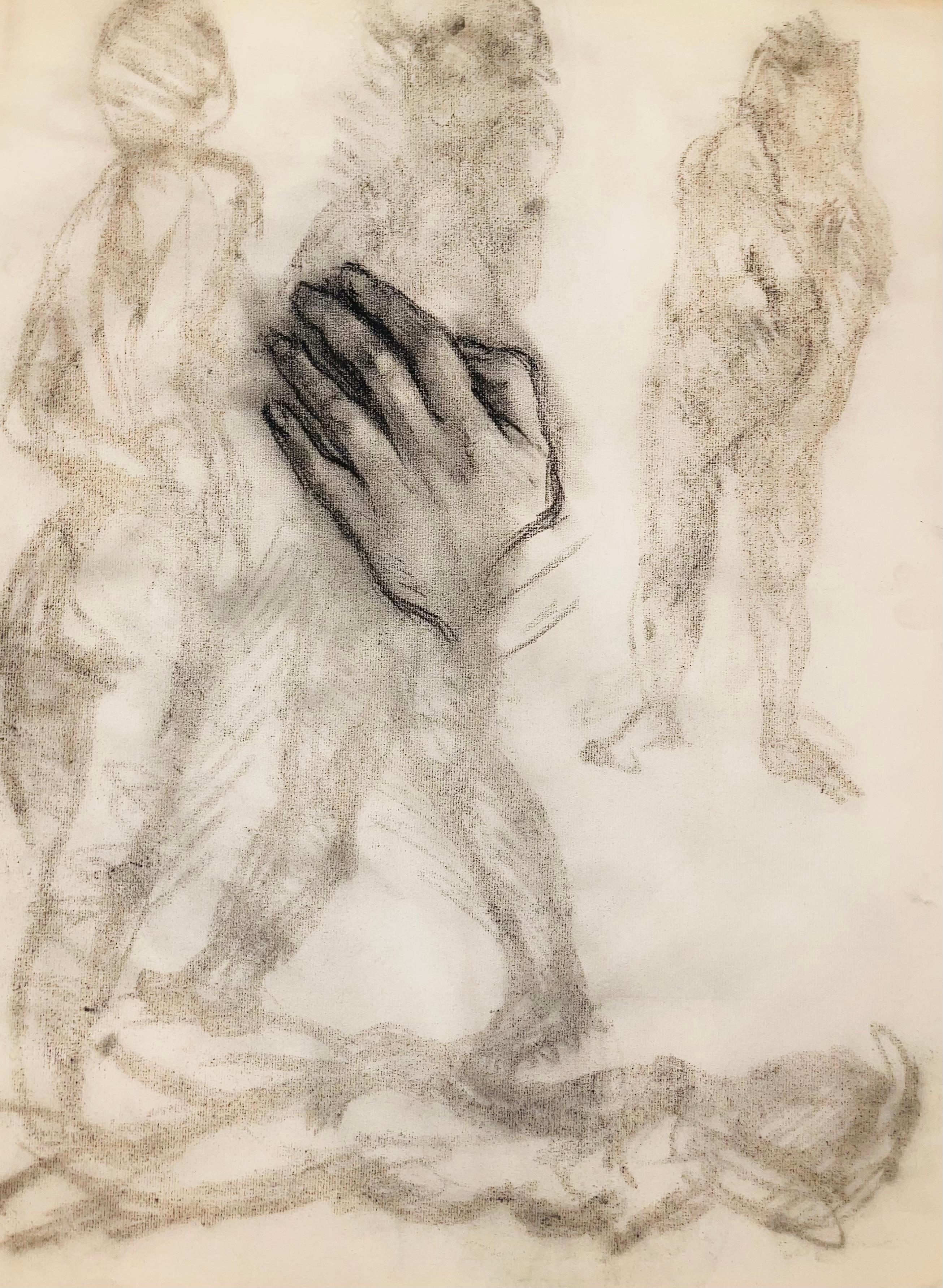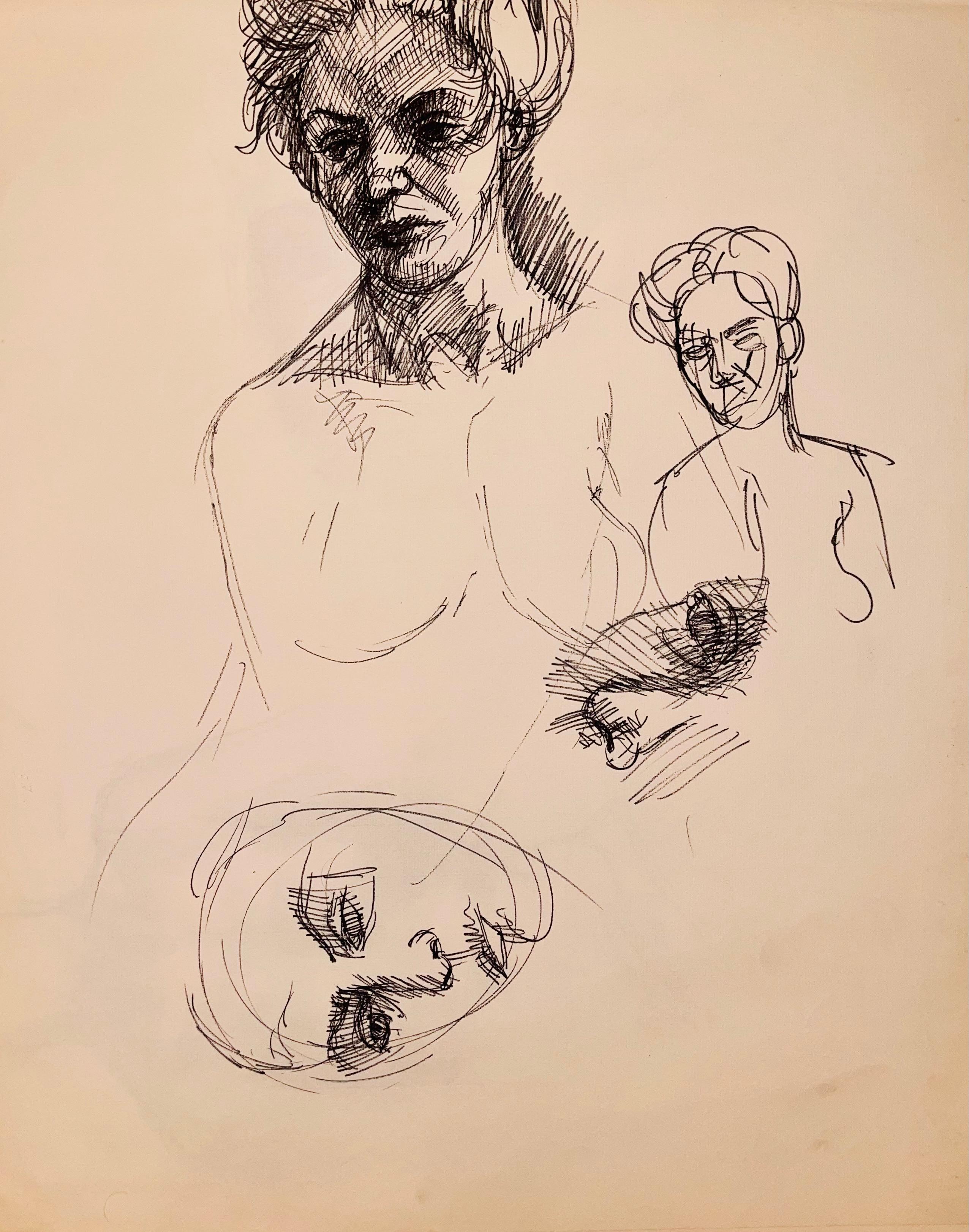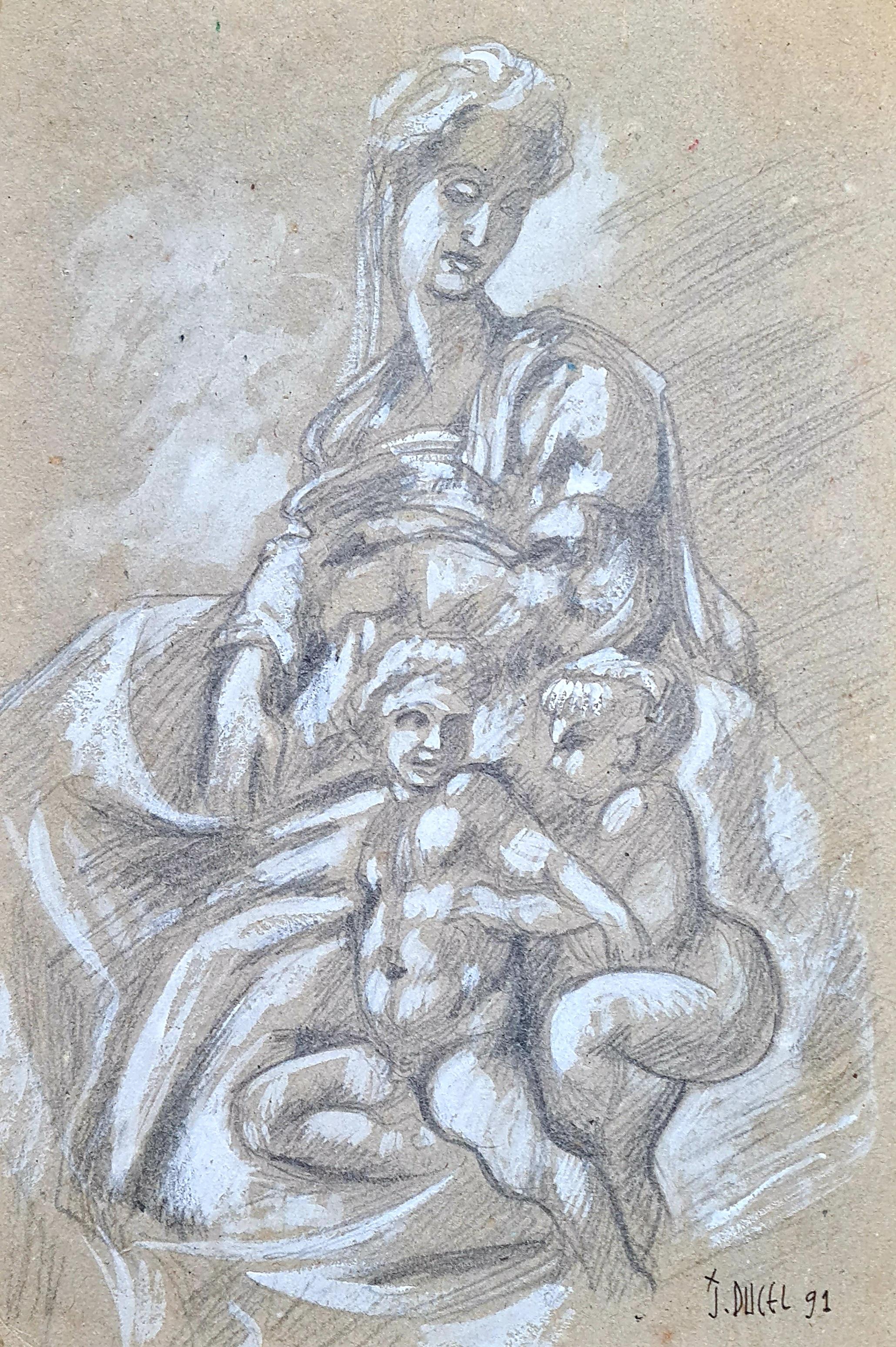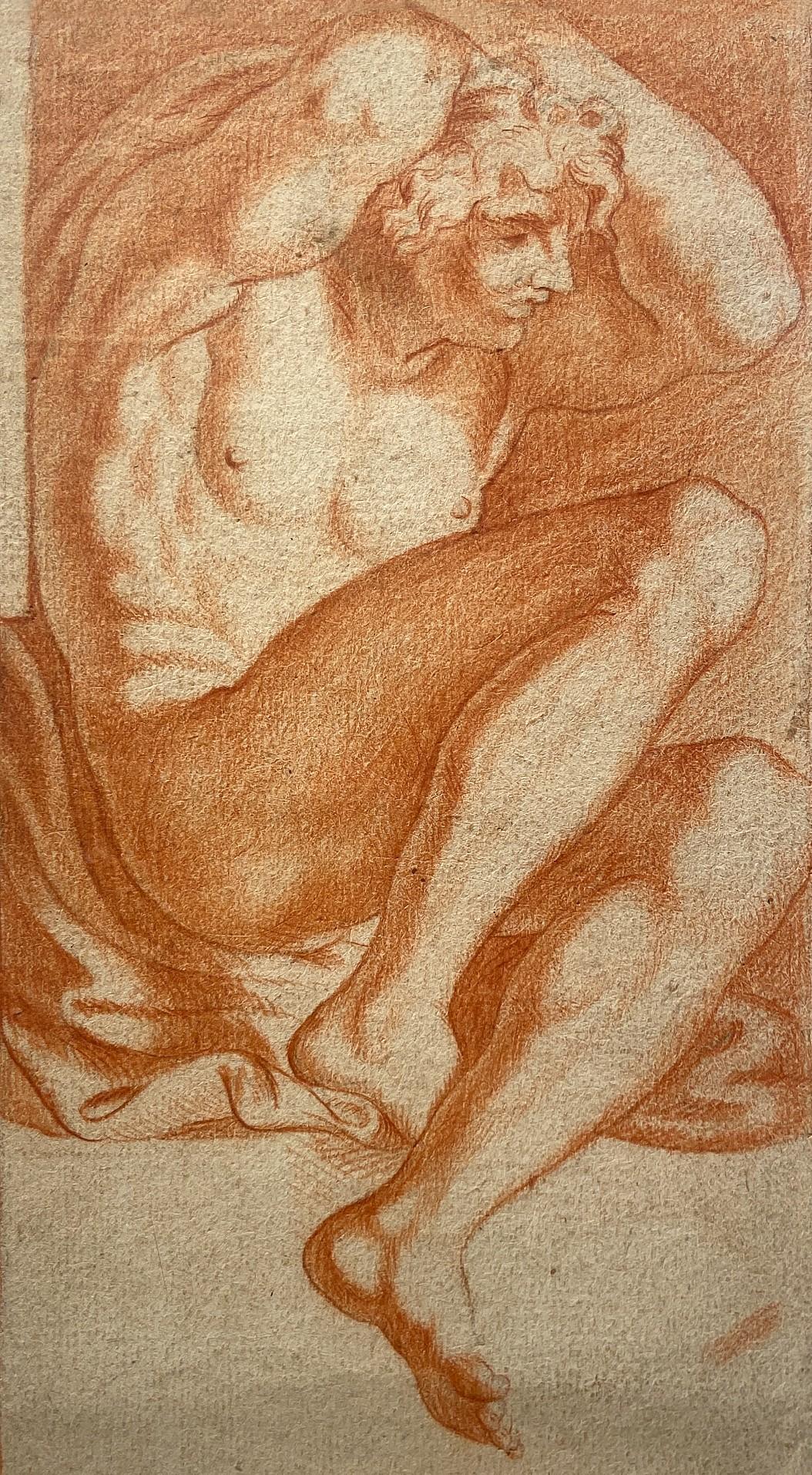Items Similar to Bartolomeo Passarotti (1529-1592) - Study Of Two Legs
Want more images or videos?
Request additional images or videos from the seller
1 of 2
Bartolomeo PassarottiBartolomeo Passarotti (1529-1592) - Study Of Two Legs1560
1560
About the Item
BARTOLOMEO PASSAROTTI
(Bologna 1529 - 1592)
Study of two legs
Pen and brown ink, over black chalk
34,5 x 21,5 cm
Bears lower left the collector mark of Maurice Marignane (L. 1872) and the collector mark of Luigi Grassi (L. 4465)
Provenance:
Collection Maurice Marignane (Born in 1879) (L. 1872);
Collection Luigi Grassi (Rome 1913-1994) (L. 4465);
Private collection, France.
We are grateful to Dr. Corinna Höper, curator at the Staatsgalerie Stuttgart and expert on Bartolomeo Passarotti's works, for confirming the authorship of Passarotti on basis of photographs (Communication of Dr. Corinna Höper dated 24 May 2023).
Full study and expertise on request.
- Creator:Bartolomeo Passarotti (1529 - 1592, Italian)
- Creation Year:1560
- Dimensions:Height: 13.39 in (34 cm)Width: 8.27 in (21 cm)
- More Editions & Sizes:UniquePrice: $15,926
- Medium:
- Movement & Style:
- Period:
- Condition:
- Gallery Location:PARIS, FR
- Reference Number:1stDibs: LU2258214335842
About the Seller
No Reviews Yet
Vetted Seller
These experienced sellers undergo a comprehensive evaluation by our team of in-house experts.
Established in 2010
1stDibs seller since 2022
- ShippingRetrieving quote...Ships From: PARIS, France
- Return PolicyA return for this item may be initiated within 14 days of delivery.
More From This SellerView All
- Study of a male nudeLocated in PARIS, FRConstance CHARPENTIER (1767-1849) Study of a male nude Charcoal and highlights with white chalk Dimensions: 56.5 x 43.87 cm Provenance Private collection, France Note A student o...Category
Early 19th Century Academic Nude Drawings and Watercolors
MaterialsCharcoal
- Jacopo Zanguidi Dit Bertoja (1544 - 1574) - Important 16th Century DrawingLocated in PARIS, FRJacopo Zanguidi BERTOJA (1544-1574) Combat of five figures, bas-relief from the School of Athens after Raphael Ink on paper 43×34cm Interesting thing According to Professor David E...Category
16th Century Renaissance Portrait Drawings and Watercolors
MaterialsInk
- Study for a frescoLocated in PARIS, FRAttributed to Francesco PENNI (1488 – 1528) Study for a fresco Pen and brown ink, brown wash heightened with white on prepared paper 14 x 12 cm On the mount, handwriting inscriptio...Category
16th Century Renaissance Figurative Drawings and Watercolors
MaterialsInk
- Frederick I of PrussiaBy Georg Philipp Rugendas the ElderLocated in PARIS, FRGeorg Philipp I RUGENDAS (1666-1742) Frederick I of Prussia Red chalk, ink and brown wash on paper 45x42 cm This drawing has been long considered representative of Charles VI. In r...Category
Early 1700s Animal Drawings and Watercolors
MaterialsInk
- Diana and her Nymphs bathingLocated in PARIS, FRAttributed to LAURENT HUBERT (Active circa 1749 - 1780) Diana and her Nymphs bathing Red and black chalk heightened with white 49,5 x 33,5 cm Provenance: Private collection, France...Category
Late 18th Century French School Figurative Drawings and Watercolors
MaterialsChalk
- Dancing Couple (recto) Various sketches (verso)By Hubert RobertLocated in PARIS, FRAttributed to HUBERT ROBERT (Paris 1733 - 1808) Dancing couple (recto) Various sketches (verso) Red chalk and charcoal on the reverse numbered in pencil “4229” circa 1770 34 x 21 c...Category
1770s Old Masters Figurative Drawings and Watercolors
MaterialsPaper, Chalk
You May Also Like
- Untitled (Renaissance Female Nude Figure Study), 1963, Ian Hornak — DrawingBy Ian HornakLocated in Auburn Hills, MIOriginal drawing on archival paper, circa 1963. Paper Size: 18 x 23 inches. Provenance: Estate of Ian Hornak, East Hampton, New York. Notes: Created during Hornak’s undergraduate st...Category
1960s Renaissance Figurative Drawings and Watercolors
MaterialsInk, Archival Paper
- Untitled (Renaissance Female Nude Figure Study), 1964, Ian Hornak — DrawingBy Ian HornakLocated in Auburn Hills, MIOriginal drawing on archival paper, circa 1964. Paper Size: 18 x 23 inches. Provenance: Estate of Ian Hornak, East Hampton, New York. Notes: Created during Hornak’s undergraduate st...Category
1960s Renaissance Figurative Drawings and Watercolors
MaterialsInk, Archival Paper
- Renaissance Style Drawing of The Medici Madonna and CherubsBy MichelangeloLocated in Cotignac, FRA pencil and watercolour drawing of a Madonna and cherubs inspired by the carvings of Michelangelo Buonarroti. Signed and dated bottom right. An elegant and charming stylised drawin...Category
Late 20th Century Renaissance Figurative Drawings and Watercolors
MaterialsCrayon, Watercolor, Pencil
- The Captive, Study of a Naked Man, Red Chalk Study, Carracci GalleryBy Annibale CarracciLocated in London, GBRed chalk on paper Image size: 11 x 5 1/2 inches (28 x 14 cm) Mounted This 18th century drawing is after the work of the 16th Century Italian artist Annibale Carraci. This figure, along with many more, were painted by Carraci in the Palazzo Farnese in a space now known as the Carracci gallery. The Carracci gallery is considered as one of the most important Renaissance commissions in Rome. This figure, along with five other companions, were known as 'The Captives'. They were designed by the artist to appear trapped in the architectural spaces in the walls and sat around the fresco that featured Perseus and Andromeda. Annibale Carracci Annibale Carracci (1560–1609) was the most admired painter of his time and the vital force in the creation of Baroque style. Together with his cousin Ludovico (1555–1619) and his older brother Agostino (1557–1602)—each an outstanding artist—Annibale set out to transform Italian painting. The Carracci rejected the artificiality of Mannerist painting, championing a return to nature coupled with the study of the great northern Italian painters of the Renaissance, especially Correggio, Titian, and Veronese.During the 1580s, the Carracci were painting the most radical and innovative pictures in Europe. Annibale not only drew from nature, he created a new, broken brushwork to capture movement and the effects of light on form. His Two Children Teasing a Cat marks a new chapter in the history of genre painting. The revolutionary potential of this new kind of painting would be taken up over a decade later by Caravaggio, who must have seen the Carraccis’ work while traveling from Milan to Rome in 1592.The Carracci saw themselves as heir to a great artistic tradition, and they consciously situated themselves within the history of northern Italian painting. Annibale and Agostino visited Parma and Venice to study the work of Correggio, Titian, Tintoretto, and Veronese. Their altarpieces and secular fresco cycles in Bologna reasserted a northern Italian emphasis on color, light, and the study of nature, but with a new focus on emotive communication. Their success led to Annibale being invited to Rome to work for the powerful Farnese family (1595). Ludovico remained in Bologna to direct the academy they founded. Through the next generation of painters—Francesco Albani, Domenichino, Guido Reni, Giovanni Lanfranco, and Guercino—Bolognese painting became the dominant force in seventeenth-century art. In Rome, Annibale’s painting was transformed through his first-hand encounter with classical antiquity and the art of Michelangelo and Raphael. Individual scenes of ancient mythology are surrounded by an elaborate illusionistic framework with feigned statues, in front of which sit muscular nude figures seemingly lit from the actual windows (Galleria Farnese ceiling). The corners are opened to painted views of the sky. When unveiled in 1600, the ceiling was instantly acclaimed as the equal of any work in the past. In combining northern Italian naturalism with the idealism of Roman painting, Annibale created the basis of Baroque art. His only challenger in Rome was Caravaggio, whose relation with the past was combative rather than assimilative. Moreover, Caravaggio’s art...Category
18th Century Renaissance Nude Drawings and Watercolors
MaterialsChalk, Paper
- The Captive, Study of a Naked Youth, Red Chalk Study, Carracci GalleryBy Annibale CarracciLocated in London, GBRed chalk on paper Image size: 5 x 8 1/2 inches (12.75 x 21.5 cm) Mounted This 18th century drawing is after the work of the 16th Century Italian artist Annibale Carraci. This figure, along with many more, were painted by Carraci in the Palazzo Farnese in a space now known as the Carracci gallery. The Carracci gallery is considered as one of the most important Renaissance commissions in Rome. This figure, along with five other companions, were known as 'The Captives'. They were designed by the artist to appear trapped in the architectural spaces in the walls and sat around the fresco that featured Perseus and Andromeda. Similarly to the original drawings, this artist has taken considerable care to sculpt his form with light and shadow, gently blending strokes on the smooth-skinned cheek and distinctly denoting the direction of hair strands. Annibale Carracci Annibale Carracci (1560–1609) was the most admired painter of his time and the vital force in the creation of Baroque style. Together with his cousin Ludovico (1555–1619) and his older brother Agostino (1557–1602)—each an outstanding artist—Annibale set out to transform Italian painting. The Carracci rejected the artificiality of Mannerist painting, championing a return to nature coupled with the study of the great northern Italian painters of the Renaissance, especially Correggio, Titian, and Veronese. During the 1580s, the Carracci were painting the most radical and innovative pictures in Europe. Annibale not only drew from nature, he created a new, broken brushwork to capture movement and the effects of light on form. His Two Children Teasing a Cat marks a new chapter in the history of genre painting. The revolutionary potential of this new kind of painting would be taken up over a decade later by Caravaggio, who must have seen the Carraccis’ work while traveling from Milan to Rome in 1592. The Carracci saw themselves as heir to a great artistic tradition, and they consciously situated themselves within the history of northern Italian painting. Annibale and Agostino visited Parma and Venice to study the work of Correggio, Titian, Tintoretto, and Veronese. Their altarpieces and secular fresco cycles in Bologna reasserted a northern Italian emphasis on color, light, and the study of nature, but with a new focus on emotive communication. Their success led to Annibale being invited to Rome to work for the powerful Farnese family (1595). Ludovico remained in Bologna to direct the academy they founded. Through the next generation of painters—Francesco Albani, Domenichino, Guido Reni, Giovanni Lanfranco, and Guercino—Bolognese painting became the dominant force in seventeenth-century art. In Rome, Annibale’s painting was transformed through his first-hand encounter with classical antiquity and the art of Michelangelo and Raphael. Individual scenes of ancient mythology are surrounded by an elaborate illusionistic framework with feigned statues, in front of which sit muscular nude figures seemingly lit from the actual windows (Galleria Farnese ceiling). The corners are opened to painted views of the sky. When unveiled in 1600, the ceiling was instantly acclaimed as the equal of any work in the past. In combining northern Italian naturalism with the idealism of Roman painting, Annibale created the basis of Baroque art. His only challenger in Rome was Caravaggio, whose relation with the past was combative rather than assimilative. Moreover, Caravaggio’s art...Category
18th Century Renaissance Nude Drawings and Watercolors
MaterialsChalk, Paper
- Untitled (Renaissance Hand and Female Nude Study), 1963, Ian Hornak — DrawingBy Ian HornakLocated in Auburn Hills, MIOriginal drawing on archival paper, circa 1963. Paper Size: 18 x 23 inches. Provenance: Estate of Ian Hornak, East Hampton, New York. Notes: Created during Hornak’s undergraduate st...Category
1960s Renaissance Figurative Drawings and Watercolors
MaterialsCharcoal, Archival Paper
Recently Viewed
View AllMore Ways To Browse
Dora Ramirez
Erte Bronze Sculpture Heat
Felice Ludovisi
Frank Borg
Krakow Witkin
Laurent Eugene Fisherman
Peintre Ziem
Robert Rudd
Roy Blakey
Shrigley Worthwhile
Soho Treasures Nj
Stephen Knight Oil Painting
Vintage Cold Palm Tree
William Kienbusch
Arundel Maine
Crak By Roy Lichtenstein
E Mary Shelley
Evening On The Schuylkill River





